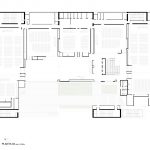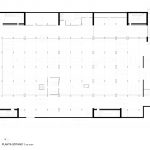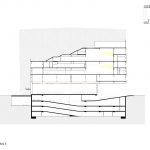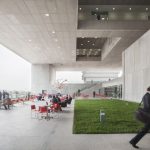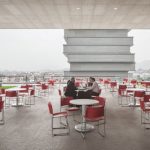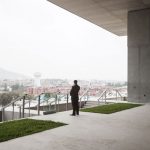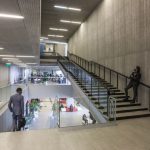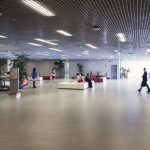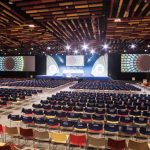Lima Centro de Convenciones (LCC) (San Borja, Lima, Perú) por IDOM. El proyecto y la construcción del Lima Centro de Convenciones (LCC) se enmarcan en el contexto del compromiso que el Estado Peruano adquirió con el Banco Mundial y con el Fondo Monetario Internacional para celebrar en Lima la Junta de Gobernadores del año 2015. El Estado Peruano vio en este evento la oportunidad de ampliar y mejorar la infraestructura congresual con la que contaba la capital del Perú.
Estratégicamente situado en el Centro Cultural de la Nación (CCN) -junto al Museo de La Nación, el Ministerio de Educación, la nueva sede del Banco de La Nación o la huaca de San Borja-, el LCC fue diseñado para responder a cuatro objetivos estratégicos: ser un motor cultural y económico del país, representar un lugar de encuentro en el corazón de la capital enraizado en la cultura colectiva peruana, convertirse en un hito arquitectónico singular, flexible y tecnológicamente avanzado, y finalmente, ser el detonante de la transformación urbana del CCN y de su entorno próximo.
Los cerca de 15.000 m2 de superficie neta se corresponden con las 18 salas de convenciones multifuncionales de diversa dimensión y proporciones -desde 3.500 a 100 m2-, que permiten la asistencia de 10.000 personas a eventos simultáneos. El resto del programa se completa con cuatro plantas de estacionamiento bajo rasante, además de diversos usos sobre rasante que dan apoyo a las salas de conferencias como áreas de traducción y gestión general del centro, almacenes y aseos, talleres y espacios de mantenimiento y distribución de material, cocinas y áreas de restauración, espacios expositivos, cafeterías y áreas de esparcimiento. Todo ello genera una superficie total construida de 86.000 m2.
Su emplazamiento estratégico permite que el LCC se posicione también como un referente urbano, gracias a su capacidad para «hacer ciudad». Tanto la implantación general como la disposición de accesos y programa permiten que la comunidad limeña pueda apropiarse con una cierta libertad de los espacios en la práctica totalidad de las plantas, con especial mención a la planta baja. De este modo el proyecto contribuye a potenciar y unificar el espacio urbano del CCN, reactivando la actual calle Comercio -conexión natural con el metro- y reforzando el carácter peatonal y cívico de esta vía, que será bautizada en un futuro próximo como Boulevard de la Cultura.
El volumen general se organiza en tres estratos físico-temporales claramente diferenciados, relacionados simbólicamente con la historia del país, el tiempo y la memoria:
El presente, representado por el gran vacío inferior -Salas de la Nación- que acoge las dos salas transformables de alrededor de 1.800 m2, una de las cuales se abra completamente al espacio urbano al recogerse los paneles acústicos que conforman su perímetro, generando una plaza urbana cubierta de más de 2.500 m2.
El pasado, el corazón del proyecto, un espacio exterior inspirado en una gran huaca -Salón de Lima- generada de forma natural por la disposición y diferencias de altura de las salas de convenciones.
El futuro, un gran volumen vítreo -Sala Internacional de las Naciones-, un espacio de convenciones altamente tecnificado que invita al resto del mundo a acercarse a Perú por su capacidad de emprendimiento y su prometedor futuro.
Tanto los sistemas constructivos como los materiales empleados en las diversas fachadas del edificio -vidrio, paneles de GRC y chapa metálica- han sido concebidos para integrarse con el entorno urbano más próximo, estableciendo una conexión en términos de materialidad con los edificios que componen el CCN.
La disposición de las salas responde tanto a las proporciones derivadas de los condicionantes acústicos y visuales como a la relación que estas mantienen con los espacios de distribución del público asistente y con la disposición de estos con las terrazas que se asoman a la ciudad. La proporción de 1/3 entre la superficie neta de salas de convenciones y el espacio de circulación de público -excluyendo las terrazas- garantizan un correcto funcionamiento del edifico. La generosa proporción entre la superficie de cada sala y la cantidad de público asistente -1,5 m2 útil por persona- asegura un espacio más que suficiente para situar en cada sala tanto los asientos como las habituales zonas de coffee-break y esparcimiento.
Las circulaciones internas se han estructurado en dos sistemas independientes, según los diferentes requerimientos respecto de la velocidad de acceso y evacuación. Por un lado, un conjunto central de ascensores y escaleras mecánicas ofrecen un rápido acceso a todos los niveles. Por otro, las escaleras de peldaños -desligadas completamente del sistema de escaleras mecánicas- recorren los diversos espacios interiores y exteriores que se suceden a lo largo de la sección, permitiendo contemplar Lima desde diversas alturas a lo largo de todas las fachadas del proyecto.
La flexibilidad operativa y funcional es una clave en el diseño integral del LCC y está orientada a maximizar el éxito económico y social del proyecto. Prácticamente todas las salas pueden ampliarse o reducirse gracias a los paneles acústicos que las limitan, posibilitando diversas configuraciones espaciales.
Técnicamente, la condición inexcusable de que la gran sala de 5.400 m2 con capacidad para 3.500 personas permaneciese libre de pilares -unida a la inconveniencia sísmica de utilizar estructuras apeadas- convierte a la propuesta conceptual y estructural en un reto, puesto que obliga a situar la gran sala en el último nivel. Situar un volumen cubierto del tamaño de un campo de fútbol a más de 30 metros de altura supone un desafío no sólo para el planteamiento estructural, sino también para la resolución de la movilidad interna -acceso y evacuación- del edificio.
Esta condición genera a su vez una cubierta plana de más de 9.000 m2 que será literalmente una quinta fachada tanto para las personas que se encuentren en el Banco de la Nación -de más de cien metros de altura- como para los que se hallen en los edificios en altura que puedan construirse en un futuro próximo. La condición de fachada de la cubierta, unida a la voluntad de simplificar los recorridos de los conductos de climatización, han determinado la posición de las máquinas de climatización en la fachada este, confiando en la envolvente para la resolución de la imagen de la misma.
Ficha técnica
Nombre: Lima Centro de Convenciones (LCC)
Proyectista: IDOM
Arquitectos responsables: Tono Fernández Usón, César Azcárate, Javier Álvarez de Tomás
Gestión del Proyecto: Javier Álvarez de Tomás
Arquitectos: María Cortés Monforte, Jorge Rodríguez, Alejandra Muelas, Enrique Alonso, Adrián Jabonero, Roberto Moraga, Armide González, Nazaret Gutiérrez, María Amparo González, Lucía Chamorro, Jesús Barranco, Magdalena Ostornol, DESSIN-TECHNISCH, Borja Gómez, Pablo Viña, Luis Valverde
Coordinación equipo Lima: Miguel de Diego
Coordinación equipo Madrid: Alejandro Puerta, Carmen Camarmo,
Estructuras: Alejandro Bernabéu, Javier Gómez, Mónica Latorre
Climatización: Antonio Villanueva, Ramón Gutiérrez, Mariano Traver, Celia Monge (SOLVENTA)
Iluminación: Noemi Barbero
Agua: Ramón Gutiérrez, Mariano Traver, Javier Martínez (SOLVENTA)
Electricidad: José Antonio Yubero, Luis Martín, Carlos Jiménez, José Manuel Jorge, Javier Martínez (SOLVENTA)
Telecomunicaciones: José Antonio Yubero, José Manuel Jorge, Carlos Jiménez, Luis Martín, Javier Martínez (SOLVENTA)
Acústica: Mario Torices
Técnicos CAD: Óscar Martín Corpa, Carlos Mendoza, Alexander Chic, Sergio Lozana
Administrativos: Banesa Marrero Castro
Cliente: Constructora OAS, Sucursal del Perú
Área: 86.000 m2
Fecha: 2015-16
Fotografía: Antonio Sorrentino / PHOSS
Contacto: http://www.idom.com
English version
Lima Convention Centre (LCC)
The project and construction of the Lima Convention Centre (LCC) is contextualized by the agreement between the Peruvian State and the World Bank and the International Monetary Fund to hold in Lima the 2015 Board of Governors. The Peruvian State saw this event as an opportunity to extend and improve the congressional infrastructure available in the capital of Peru.
Strategically located in the Cultural Centre of the Nation (CCN) -next to the National Museum, the Ministry of Education, the new headquarters of the National Bank or the Huaca San Borja- the design of the LCC was to satisfy four strategic objectives: being a cultural and economic motor for the country, representing a meeting place at the heart of the city enrooted in the collective Peruvian culture, turning into a unique, flexible and technologically advanced architectonic landmark and finally, triggering the urban transformation of the CNN and its surroundings.
The near 15,000 m2 of net area correspond to the 18 multipurpose convention halls, their sizes and proportions varying from 3,500 m2 to 100 m2, which allow for up to 10,000 people to attend simultaneous events. The rest of the programme is completed by four underground car-park floors as well as several uses above ground that complement the conference rooms. These would include areas for translation and general management of the centre, stockrooms and toilets, workshops and areas for maintenance and material distribution, kitchens and dining areas, exhibition halls, cafeterias and relaxation areas. This all generates a total built up area of 86,000 m2.
Its strategic location grants the LCC the possibility of becoming an urban landmark, thanks to its community-building capacity. Both the general implantation and the disposition of entrances and programme allow for the people of Lima to make almost the entire facility theirs with a certain degree of liberty, particularly the ground floor. In this way, the project contributes to enhance and unify the urban area of the CCN, revitalizing the current Comercio Street -natural link with the underground- and reinforcing its pedestrian and civic character, which in the near future will be baptized Culture Boulevard.
The general volume is organized into three time-physical strata clearly differentiated, symbolically related to the country’s history, time and memory: The present is represented by the great internal void -Nation Rooms- which harbours the two transformable rooms of about 1,800 m2, one of which can open up entirely to the city by clearing its perimeter of the acoustics panels that make it up, generating a sheltered urban plaza over 2,500 m2.
The past, the heart of the project, is an outdoor area inspired by a great huaca -Lima Lounge- generated naturally by the disposition and the difference in height of the convention halls.
The future is a great vitreous volume -International Room of Nations-. It’s a highly technical conventions facility which invites the rest of the world to come to Peru for its entrepreneurial capacity and its promising future.
Both the construction methods and the materials used on the different elevations of the building -glass, GRC panels and metal-sheet- have been conceived to blend in with their immediate urban surroundings, establishing a link in terms of appearance with the buildings that make up the CCN.
The layout of the rooms is in line with both the proportions derived from the acoustic and visual conditions and the relation between these and the public distribution spaces and the disposition of these and the terraces that overlook the city. The 1/3 ratio between the net area of the convention halls and the public circulation area -not including terraces- guarantees the correct functioning of the building. The generous proportion between the area of each room and the number of people attending the venue -1.5 m2 per person- ensures more than enough space to put in each room both the seats and the usual coffee-break and relaxation areas.
Internal flow patterns have been structured as two independent systems, according to the different requirements regarding access and evacuation speeds. A central set of escalators and lifts offer quick access to all levels. On the other hand, staircases -totally independent from the escalators system- go through the different interior and exterior areas of the building, allowing for the contemplation of Lima from varying heights from all the building’s façades.
The operative and functional flexibility are keys to the comprehensive design of the LCC and are orientated towards maximizing the economic and social success of the project. Nearly all rooms can be extended or reduced thanks to the acoustic panels that limit them, making it possible to have several spatial distributions.
Technically, the mandatory condition by which the great 5,400 m2 room, with capacity for 3,500 people, was to be free from pillars -along with the seismic inconvenience of using propped up structures-, turns the conceptual and structural proposal into a challenge, since it implies putting the great room on the last level. Placing a sheltered volume the size of a football pitch at a height of over 30 m is a challenge to both the structural approach and the building’s internal mobility -access and evacuation-.
This condition in turn generates a 9,000 m2 flat roof which will literally be a fifth façade for the people in the National Bank -over 100 m tall- as well as for whoever might be in the high-rise buildings that might be erected in the future. This façade condition of the roof, along with the will to simplify the routes of the HVAC ducts, have determined the position of the HVAC machinery on the East elevation. It is left to the building envelope to solve its image.












